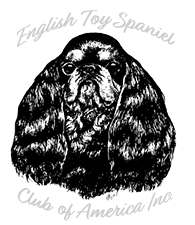The medical treatises of Dr. Caius, physician to Queen Elizabeth I, describe a spaniel with many of the characteristics that we know as typically Charlie today. The dogs he described were merry playmates of dainty ladies given to sitting in their laps, keeping them company, sleeping in their beds and eating at the table with them. His description could fit almost any pampered ETS today, for the Charlie is a consummate companion.
It is always amusing to send a Charlie off to a new fancier, for no matter how the new owner keeps his dogs of other breeds, the Charlie exempts him or herself from the house rules. It is almost as if they are genetically programmed to wind up on the furniture, in the bedroom, at the table, begging for treats.
Dr. Caius recommended that the dogs were able to soothe the sickness of the stomach. They were worn as ‘plasters’ by the sick and weak people so that the warmth of their bodies could transfer to the patient. Making the patients well, it seems , often cost the little companion dog its life. Even today, there are a few examples of love more freely given that to ill with a Charlie at hand. The dog will without your bidding glue itself to your side and will seem to will you, its beloved master well. It is easy to understand how the early physician would consider the dogs as living heating pads.
The loving, companion characteristics of the breed have made it a frequent artist’s subject through out history, and there are many examples in paintings of these little dogs. The dogs in the historic paintings show the characteristic round, domed head and low-set ears. The noses are short – not exaggerated as today, but definitely shorter than the modern day Cavalier Spaniel with which this breed is often linked. It was these depictions of little sweet-faced dogs that first piqued my interest in the breed, for I wondered what had become of the little lap dogs in the paintings. Their descendants, the English Toy Spaniel, are in the ring and at homes today.
